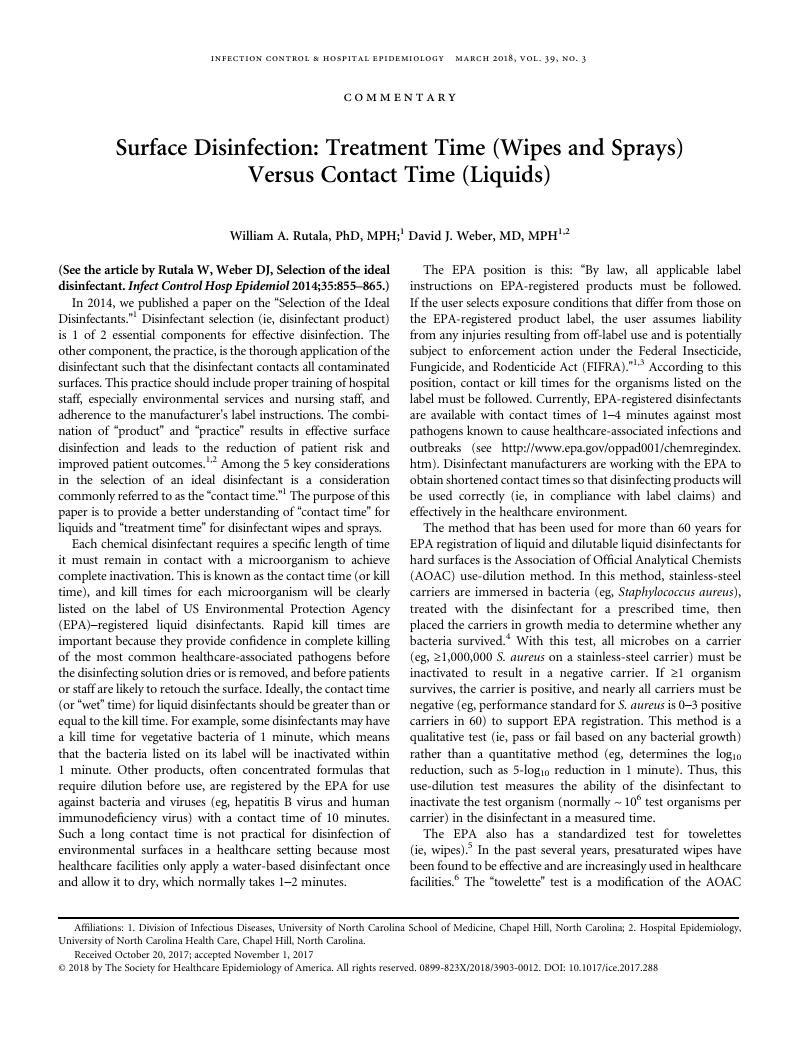Crossref Citations
This article has been cited by the following publications. This list is generated based on data provided by Crossref.
Rutala, William A.
and
Weber, David J.
2019.
Best practices for disinfection of noncritical environmental surfaces and equipment in health care facilities: A bundle approach.
American Journal of Infection Control,
Vol. 47,
Issue. ,
p.
A96.
Croke, Lisa
2019.
Guideline for environmental cleaning.
AORN Journal,
Vol. 110,
Issue. 6,
Rutala, William A.
and
Weber, David J.
2019.
Disinfection, sterilization, and antisepsis: An overview.
American Journal of Infection Control,
Vol. 47,
Issue. ,
p.
A3.
Teska, Peter J.
Li, Xiaobao
and
Gauthier, Jim
2019.
Wet contact time directly impacts antimicrobial efficacy of Environmental Protection Agency–registered disinfectants.
American Journal of Infection Control,
Vol. 47,
Issue. 4,
p.
474.
Tyan, Kevin
Levin, Adriane
Avalos-Pacheco, Alejandra
Plana, Deborah
Rand, Eleanor A
Yang, Helen
Maliszewski, Laura E
Chylek, Lily A
Atta, Lyla
Tye, Mark A
Carmack, Mary M
Oglesby, N Synclaire
Burgin, Susan
Yu, Sherry H
LeBoeuf, Nicole R
and
Kemp, Jacqueline M
2020.
Considerations for the Selection and Use of Disinfectants Against SARS-CoV-2 in a Health Care Setting.
Open Forum Infectious Diseases,
Vol. 7,
Issue. 9,
Brown, Elizabeth
Dhanireddy, Karthik
Teska, Peter
Eifert, Joseph
Williams, Robert C.
and
Boyer, Renee
2020.
Influence of drying time on prewetted disinfectant towelettes to disinfect glass surfaces.
American Journal of Infection Control,
Vol. 48,
Issue. 7,
p.
846.
Song, Xinyu
Cvelbar, Uros
Strazar, Petra
Vossebein, Lutz
and
Zille, Andrea
2020.
Antimicrobial Efficiency and Surface Interactions of Quaternary Ammonium Compound Absorbed on Dielectric Barrier Discharge (DBD) Plasma Treated Fiber-Based Wiping Materials.
ACS Applied Materials & Interfaces,
Vol. 12,
Issue. 1,
p.
298.
Chen, Bo
Han, Jie
Dai, Han
and
Jia, Puqi
2021.
Biocide-tolerance and antibiotic-resistance in community environments and risk of direct transfers to humans: Unintended consequences of community-wide surface disinfecting during COVID-19?.
Environmental Pollution,
Vol. 283,
Issue. ,
p.
117074.
Jara, Barbara J.
2021.
Infection Prevention in the Era of COVID-19: 2021 Basic Procedure Review.
Journal of Nuclear Medicine Technology,
Vol. 49,
Issue. 2,
p.
126.
Kim, Seong Chan
Kwak, Dong-Bin
Kuehn, Thomas
and
Pui, David Y.H.
2021.
Characterization of handheld disinfectant sprayers for effective surface decontamination to mitigate severe acute respiratory coronavirus virus 2 (SARS-CoV-2) transmission.
Infection Control & Hospital Epidemiology,
Vol. 42,
Issue. 7,
p.
901.
Lee, Hae-Won
Yoon, So-Ra
Song, Hyeyeon
Park, Boyeon
and
Ha, Ji-Hyoung
2021.
Optimizing Operating Parameters of Electric Ultra-Low Volume Sprayer with Slightly Acidic Electrolyzed Solution for Efficient Virucidal Activity on Environmental Surfaces.
International Journal of Environmental Research and Public Health,
Vol. 18,
Issue. 19,
p.
10183.
Rutala, William A.
and
Weber, David J.
2021.
Disinfection and Sterilization in Health Care Facilities.
Infectious Disease Clinics of North America,
Vol. 35,
Issue. 3,
p.
575.
Yang, Yan-Qiu
and
Zhao, Shuo-Yang
2022.
Application of Pulsating Vacuum Cleaning Technology to Medical Devices Cleaning.
Journal of Biomaterials and Tissue Engineering,
Vol. 12,
Issue. 5,
p.
984.
Kelley, Alyssa M.
Voorn, Maxwell G.
Tembo, Geraldine M.
Horn, Connor M.
Li, Xiaobao
Teska, Peter J.
and
Oliver, Haley F.
2023.
Contact time has limited impact on the efficacy of disinfectant towelettes when tested under conditions reflective of realistic use.
Antimicrobial Resistance & Infection Control,
Vol. 12,
Issue. 1,
Rutala, William A.
Boyce, John M.
and
Weber, David J.
2023.
Disinfection, sterilization and antisepsis: An overview.
American Journal of Infection Control,
Vol. 51,
Issue. 11,
p.
A3.





